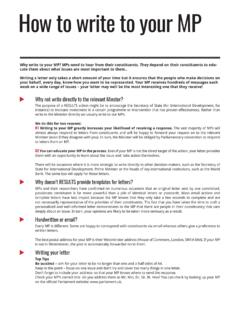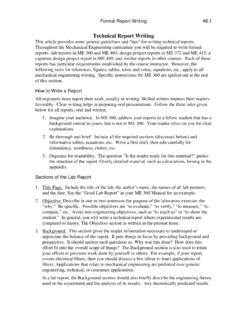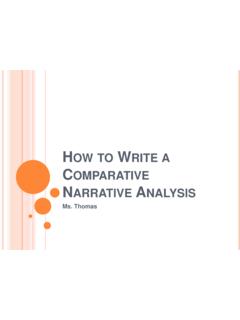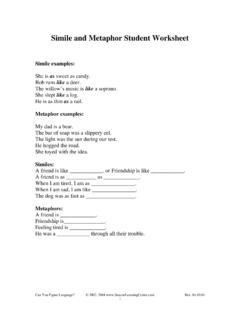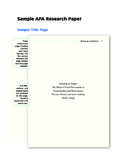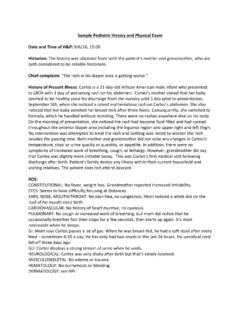Transcription of Writing and publishing a useful and interesting Case Report
1 Writing andpublishing a usefuland interestingCase ReportHow many junior doctors have published original laboratory-based research from their student days, an audit or clinical study from their first two years on the ward or have national and international presentations under their belt at the time of application for core training? Whether publication is perceived essential to postgraduate learning, there is no doubt that inclusion of publication experience in a training portfolio is essential for junior doctors applying for jobs. Even with time set aside for research and audit in clinical work and opportunities in academic posts, most doctors applying for jobs seek out opportunities to publish and present nationally or case Reports, launched in November 2008, was developed purely for the publication of case reports there are more than 7,000 currently available from authors in more than 70 countries.
2 It is an online only journal, has all the tradition of the BMJ, is peer reviewed, referenced and boasts an archive available at the click of a mouse of cases listed by specialty from anaesthesia to urology. All material, including pictures, is free to subscribers (Fellows) to use for further clinical teaching. We have an editorial board and a huge range of reviewers who peer review not just the science and the medicine of the article, but see the process of Writing and rewriting the manuscript through with the authors to the final production of what is, for many, their first publication. We base our decision to publish on two principles: First, healthcare workers including medical students and junior doctors must find the cases a valuable learning resource, both relevant and engaging.
3 Second, there is more to learn from common cases that present in an unusual way, present a diagnostic, ethical or management challenge or where there are pitfalls to learn from, than from rare or exotic cases that most of us are unlikely ever to have to manage. Instead we suggest that you:Use the Word templates at and start Writing up a clinical case that you think demonstrates valuable clinical or ethical lessons for an audience of medical students or junior doctors. Take any clinical pictures you need to illustrate your case (download our consent form to use in addition to the consent forms you use locally) and then write your article in our template under the following headings: Summary Background case presentation Investigations Differential diagnosis Treatment Outcome and follow-up Discussion Learning points/take home messagesSo, go ahead and start look forward to seeingyour gives you the first draft of the Report which you should show to a senior colleague at work or in university.
4 Without any delay send this off to us and we will help you shape it into a publishable manuscript using the comments of our reviewers. The case reports most likely to be accepted are well -written, with a clear discussion of management decisions and lessons to be learned. We welcome a brief summary and discussion of relevant guidelines, pitfalls and the prevailing evidence, and, schematics that illustrate the mechanism of an injury or pathology. It is not unusual for cases to pass between reviewers and authors several times before a final polished article is accepted. An annual subscription (Fellowship) gives myou the freedom to submit as many cases as you like as well as access to and reuse of all the published material. We have institutional Fellowships so speak to your tutors and postgraduate managers about an institutional subscription.
5 We are about to begin a global health blog as so many of our contributors and reviewers are truly global and comprise a spectrum of medical backgrounds. This leaves us ideally placed to publish cases from student electives and, for students and doctors seeking placements abroad, to network and find a suitable clinical guidanceThe most difficult problem we face in review of manuscripts is poor language or grammar. It is a huge shame to reject articles because they are badly written when the message they contain is language reflects the authors, their institution and the journal, and inevitably, presentation and style hugely influences the perception of the management of any case . Read the case presentation back to yourself. Is there a natural flow from presentation to discharge and follow-up?
6 Are all decisions explained? Don t be afraid to write about complications. They are universal and learning from each other s experience is key in medicine. Do discuss these with clarity so that all findings and management decisions are obvious. The audience are not reading to approve or disapprove but need to be in a position to make sense of the story. The discussion of pitfalls is the single biggest contribution to learning in case reports: Unusual presentations of common cases Inconclusive results Grey areas in indications for treatment Management challenges Near missesTitle of caseYou do not need to include a case Report in the title you may be cryptic if you will be freely available online. Up to 150 words summarising the case presentation and outcome.
7 We need a good flavour of the case emphasise the learning you think this case is important why did you write it up? Why is the case of interest to our readers? Is this a prevalent health problem? Is there a clear message? case presentationPresenting features, medical/social/family history. This is the patient s story but please be sensitive to patient confidentiality. How did they present? What is the relevant history? Why is this relevant? Explain your findings and how they influenced your decisionsDo not use abbreviations for diseases or relevant. All investigations that create a background (baseline) picture are investigations that are crucial to management decisions should be discussed in full. Chose appropriate images and videos to illustrate your point (maintaining patient confidentialityExample of a well presented case ReportResection of a large carotid paraganglioma in Carney-Stratakis syndrome: a multidisciplinary featRebecca Spenser Nicholas, Ayyaz Quddus, Charlotte Topham, Daryll BakerPublished: 16 April 2015 What to include in the submissiontemplate for full casesDifferential diagnosisIf relevant.)
8 Please don t list these. What we want to see is how the final diagnosis is teased out. What are the consequences to management or treatment for the differential diagnoses? For example: A man in his 60s who has smoked for 40 years and presents with epigastric pain radiating posteriorly may have a leaking abdominal aortic aneurysm, acute pancreatitis or a perforated duodenal ulcer. Particular historical details and investigations separate these diagnoses, and treatment of each is vastly different; indeed, treating one cause for the other is detrimental. Discuss these and the pitfalls that may relevant. Include pharmacological and nonpharmacological, eg, surgery, physiotherapy, supportive care. Outcome and follow-upAlways include follow up data where you can; it gives readers a clear understanding of outcome.
9 The follow-up period should be defined. Please state if the patient has died even if not directly related to your case . DiscussionInclude a very brief review of similar published cases. This is the opportunity to describe mechanisms of injury, guidelines and their relevance, diagnostic pathways (use diagrams if you like) and the points of interest of the case . A brief summary of relevant clinical guidelines is appropriate. Did you have to make an exception? Did you have to adapt the guidelines?Learning points/take home messages3 to 5 bullet points. This is a required field. These are the most crucial part of the case what do you want readers to remember when seeing their own patients?ReferencesInclude only relevant references including guidelines in Vancouver captionsWe do not have a limit on illustrations but choose only what illustrates your case most effectively.
10 We encourage colour images and video s perspectiveThis is an optional section to give the patient the opportunity to comment on their experience only very relevant personal and family details should be informationIn addition to the guidance in this template please read the instructions to authors online. You must have signed informed consent from patients (or relatives/guardians) before submitting to BMJ case Reports. Please anonymise the patient s details as much as possible, eg, specific ages, occupations. Consent forms are available in several or your institution must be a Fellow of BMJ case Reports in order to submit. Fellows can submit as many cases as they like, access all the published material, and re-use any published material for personal use and teaching without further more information on rates and how to purchase your fellowship more information, please your librarian or head of department to see if your institution already has a Fellowshi


